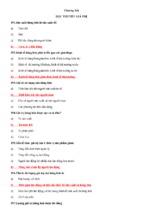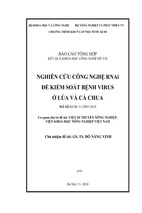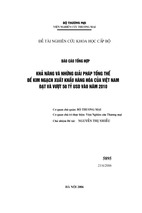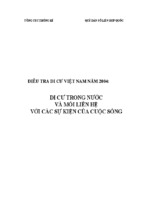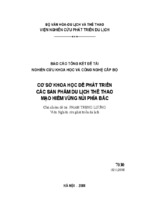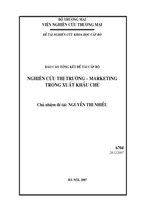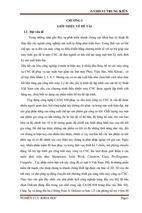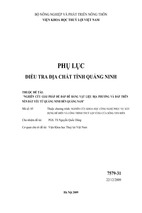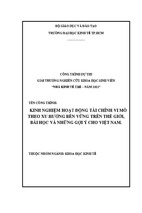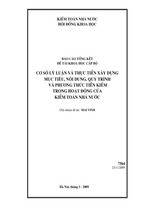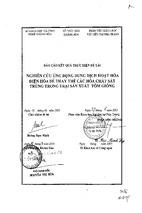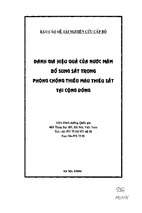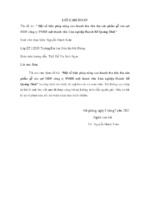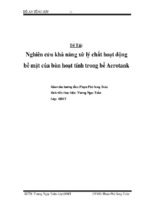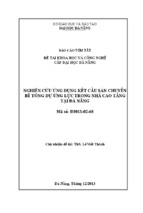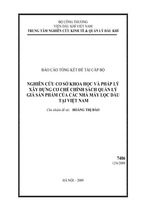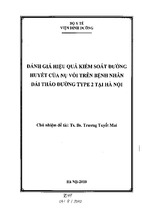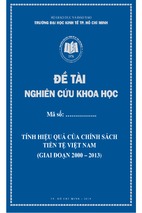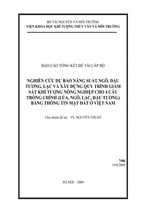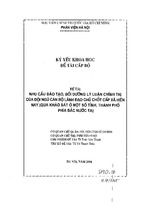DECLARATION OF ORIGINALITY
AND WORD COUNT
I hereby declare that the graduation project is based on my original work except for
quotations and citations which have been duly acknowledged. I also declare that it has
not been previously or concurrently submitted for any other course/degree at Help
University College or other institutions. The word count is 12,381 words.
______________________
LUU QUYNH LY
28 June, 2010
1
ACKNOWLEDGEMENT
This project would not have been made possible without the assistance, support and
encouragement of many people. I wish to take this opportunity to thank all the people
who have helped me during the time of completing the dissertation.
Firstly, I would like to express my deep gratitude to my supervisor Dr. Le Van Lien,
International School, Vietnam National University Hanoi. He has kindly helped me and
supported me all the way through. For that, I am very grateful. I also would like to
express my thank to Ms. Sumathi and Ms. Shenba, Help University College, who
initiated the project and give so much instruction and support.
Additionally, I would like to thank the interview participants: Mrs. Phan Thi ThuyDeputy Managing Director of Vietcombank, and Mr. Dau Hoang Minh- the Business
Solution Manager of TNT Express Worldwide Ltd. who took their precious time to help
me to conduct the interview. I also would like to extend my special thanks to managers,
accountants, my friends, and other people who have help me to carry out the survey. I
want to thank them for all their support, interest and valuable hints.
Last but not least, I would like to express my deep appreciation to my mother who
provided me critical commentary which is very important for completing this project.
I would like to delicate this project to my family, especially to my beloved father. Thank
you for always loving, supporting and believing in me.
LUU QUYNH LY
2
THE IMPORTANTCE AND EFFECT OF CSR REPORTING ON THE
PERFORMANCE OF VIETNAM COMPANIES
By
LUU QUYNH LY
Jun 2010
Supervisor: Dr. Le Van Lien
ABSTRACT
CSR has become a burning issue in the world. As Vietnam is among the world’s fastestgrowing economy, CSR has become even more important for the country to develop
sustainably. This paper aims to discover how organizations in Vietnam view CSR and
CSR reporting, whether CSR information have any effect on the Vietnam customer
behavior, and the attitude of Vietnam accountant toward CSR reporting. The results of
the study provide evidence that there is strong support for CSR from managers and a
growing awareness among consumers and accountants. Nevertheless, there is
expectation gap between how people perceive and how people act because there are lack
of adequate CSR disclosure from firm, and not-so-enthusiastic support actions from
consumers due to the barriers in living expenses, and low effective CSR communication
tools that companies use. However, with highly positive attitude toward the important of
CSR and the willingness to learn and gain more knowledge about this issue found from
the survey have drawing potential bright future for CSR in Vietnam.
3
TABLE OF CONTENTS
DECLARATION OF ORIGINALITY AND WORD COUNT ................................................ 1
ACKNOWLEDGEMENT ............................................................................................................ 2
ABSTRACT ................................................................................................................................... 3
TABLE OF CONTENTS .............................................................................................................. 4
LIST OF FIGURES ...................................................................................................................... 6
LIST OF ABBREVIATIONS ...................................................................................................... 7
1.
2.
3.
INTRODUCTION ................................................................................................................. 8
1.1.
CSR in the world........................................................................................................... 8
1.2.
CSR in Vietnam ............................................................................................................ 9
1.2.1.
Government actions ...................................................................................................... 9
1.2.2.
Vietnamese Accounting Standards (VAS) ................................................................. 10
1.2.3.
CSR practice and challenges....................................................................................... 11
1.3.
Reasons for further investigation ................................................................................ 12
LITERATURE REVIEW ................................................................................................... 14
2.1.
Definition and conceptualization of CSR ................................................................... 14
2.1.1.
Carroll's 1979-1991 conceptualization ....................................................................... 15
2.1.2.
Wood 1991 conceptualization .................................................................................... 17
2.1.3.
Argandona and Hoivik (2010)’s ethical concept ........................................................ 19
2.2.
Stakeholder theory ...................................................................................................... 20
2.3.
Social accounting ........................................................................................................ 22
2.4.
CSR reporting ............................................................................................................. 23
2.5.
Hypothesis .................................................................................................................. 26
2.5.1.
Management’s attitude toward CSR and CSR reporting ............................................ 26
2.5.2.
Consumer’s attitude toward CSR information and disclosure.................................... 29
2.5.3.
Accountants’ attitude toward CSR reporting .............................................................. 31
RESEARCH METHODOLOGY ....................................................................................... 33
3.1.
Research objective ...................................................................................................... 33
3.2.
Research methodology................................................................................................ 33
3.3.
Data source ................................................................................................................. 33
4
4.
5.
3.3.1.
Secondary data ............................................................................................................ 34
3.3.2.
Primary data ................................................................................................................ 34
3.4.
Research method ......................................................................................................... 35
3.5.
Research tool............................................................................................................... 35
3.5.1.
Questionnaire .............................................................................................................. 35
3.5.2.
Personal interview....................................................................................................... 36
3.5.3.
Annual reports............................................................................................................. 36
3.6.
Data collection ............................................................................................................ 36
3.7.
Sampling ..................................................................................................................... 37
3.7.1.
Sample population ...................................................................................................... 37
3.7.2.
Sample frame .............................................................................................................. 37
3.7.3.
Sample size ................................................................................................................. 38
3.7.4.
Sample techniques ...................................................................................................... 38
3.8.
Limitations .................................................................................................................. 38
FINDINGS AND ANALYSIS ............................................................................................. 39
4.1.
Management................................................................................................................ 41
4.1.1.
Findings from questionnaire survey ........................................................................... 41
4.1.2.
Actual CSR disclosures by firms ................................................................................ 46
4.1.3.
Findings from managers interview ............................................................................. 47
4.1.4.
Overall evaluation of management’s responses.......................................................... 49
4.2.
Consumers .................................................................................................................. 51
4.2.1.
Findings from questionnaire survey ........................................................................... 51
4.2.2.
Overall evaluation of consumer’s responses .............................................................. 53
4.3.
Accountants ................................................................................................................ 57
4.3.1.
Findings from questionnaire survey ........................................................................... 57
4.3.2.
Overall evaluation of accountant’s responses ............................................................. 59
4.4.
Overall discussion ....................................................................................................... 61
CONCLUSION .................................................................................................................... 65
REFERENCES ............................................................................................................................ 69
APPENDIX A: QUESTIONNAIRE .......................................................................................... 80
APPENDIX B: STATISTICAL TEST ...................................................................................... 85
5
LIST OF FIGURES
Figure 2.1. A hierarchy of CSR (adapted from Carroll, 1991) ..................................................... 17
Figure 2.2. The CSP Model (adapted from Wood, 1991) ............................................................. 18
Figure 4.1. Respondents ................................................................................................................ 39
Figure 4.2. Consumer and accountant categories ......................................................................... 40
Figure 4.3. Distribution of responses from management survey .................................................. 42
Figure 4.4. Distribution of responses from management survey (percentage) ............................. 43
Figure 4.5. Descriptive statistics 1 (management survey) ............................................................ 44
Figure 4.6. Descriptive statistics 2 (management survey) ............................................................ 45
Figure 4.7. Distribution of responses from consumer survey ....................................................... 52
Figure 4.8. Distribution of responses from consumer survey (percentage) .................................. 53
Figure 4.9. Descriptive statistics 1 (consumer survey) ................................................................. 54
Figure 4.10. Descriptive statistics 2 (consumer survey) ............................................................... 56
Figure 4.11. Distribution of responses from accountant survey ................................................... 58
Figure 4.12. Distribution of responses from accountant survey (percentage) .............................. 60
Figure 4.13. Descriptive statistics 1 (accountant survey) ............................................................. 60
Figure 4.14. Descriptive statistics 2 (accountant survey) ............................................................. 61
6
LIST OF ABBREVIATIONS
CSR
Corporate Social Responsibility
CSP
Corporate Social Performance
IAS
International Accounting Standard
IQR
Inter-Quartile Range
MOF
Ministry of Finance
NGO
Non-governmental Organization
PR
Public Relation
TBL
Triple Bottom Line
VSA
Vietnamese Accounting Standard
7
1.
INTRODUCTION
1.1.CSR in the world
Corporate Social Responsibility (CSR) in the world is not new but it is still a hot subject
for enterprise, investors, customers, and entire society. Over the world, giant
corporations pay a lot of money in order to become perfect business model and
responsible for society. Typically, Best Buy Co., Inc, a retailer of consumer electronics
in USA and Canada, has applied recycled goods program. The same example is
Starbucks, a world-wide coffee company, also has many activities for community.
Besides, Evian Company, a French mineral water producer, distributes their product in
environment-friendly water bottle. Moreover, unbeatable web search engine "Google",
with head office called Googleplex, treats their staffs as golden. Also, General Electrics
uses more than two billion USD yearly for studying new technologies to protect
environment. Deputy Manager of public relations of Best Buy Company says, “We only
feel that we will succeed in the market if we take responsibilities for society” (Saga
Vietnam, 2008). Besides having quality assurance of staffs' living standard, protecting
environment, and making useful products for customers and environment, companies
also raise funds for charity and donation for the development of society and community.
For example, Royall Dutch Shell, a long-standing oil Corporation, built lots charitable
funds, one of them is the Early Learning Centre in South Africa which educates children
and teaches skills to mature people. World Bank and Merck Pharmacy Company also
have ideals to raise charitable fund of USD 50 millions, in which, they give free
8
Mectizan medicine to eliminate illness in 28 countries in Africa (Saga Vietnam, 2008).
Besides, billionaires also use their fortune to contribute significantly in social activities
such as Bill Gates and Warren Buffett. CSR report enclosed with annual business reports
appear in most companies.
1.2.CSR in Vietnam
In Vietnam, CSR is a relative new concept. It is firstly introduced by international
corporations sourcing in Vietnam under the form of Code of Conduct or social standard
requirements. According to Professor André Schmitt, Director of CFVG, “Current
financial crisis show that Vietnam Economy was depended on supply chains of the
world. Vietnam Economy can not evade the global competitive pressures. Thus, the task
of implementing CSR is as difficult as it is in any developed countries” (CSR Vietnam
Forum, 2009). Presently, events such as pollution in Thi Vai River, contaminated China
milk, conflict between workers and their bosses have proved that implementing CRS is
necessary for sustainable economy.
1.2.1. Government actions
“Sustainable development and protecting the environment” is the commitment Vietnam
government set in the national strategy SRV 1993:45, which along with most nations in
the world (O’Rourke, 1995). The Doi Moi reforms and open-door policies, implemented
since 1986, have helped Vietnam to achieve high economic growth, however major
9
social problems still remain. In order to tackle those problems, the Vietnam government
had created new regulations, Environmental Protection Law and the Vietnam Agenda 21
for sustainable development. Other legislative tools also include Labor Code
enforcement and labor inspection. Besides, the government also established
Environmental Police and special fees levied on the emission of wastewater to
strengthen enforcement measures against companies that pollute. Moreover, the
government strongly expresses its commitment and puts effort in calling on companies
to protect the environment and promote safety and health in the workplace (Civil Law
Network, 2009). The violations of the Labor law and Environmental law would cause
company to incur cost of monetary penalties, to be suspended, or in severe case, to be
imprisonment. However, there is no requirement from government for the companies to
formally issue CSR reporting.
1.2.2. Vietnamese Accounting Standards (VAS)
In February 12, 1999, the Vietnam Accounting Standards Board (VASB) was
established by the Ministry of Finance (MOF). Presently, basing on the International
Accounting Standard (IAS), the VAS is set up by the MOF through the Accounting
Policy Department. With the IAS base, Vietnamese considerations are used to adjust
economic, finance and accounting issues when VAS is drafted. There are some
differences in disclosure requirement between two standards. Under the VAS 21
Presentation of Financial Statement, which is derived from IAS 1, bonuses and welfare
funds for employees are not required to disclosure. In Vietnam, retirement benefits are
10
paid by companies under compulsory levy, the companies charge this contribution
against operating costs. Besides, comparing to the IAS 19 Employee Benefits, there are
no other disclosure requirements for retirement benefits in VAS. Moreover, Vietnam
does not have standard specifically addressing areas which are established under IAS 26
Accounting and Reporting by Retirement Benefit Plans. Thus, it can be seen that VAS
does not have any special requirement for the enterprise to disclose employee benefits.
Also, the VASB does not require the company to disclose CSR information (Vietnamese
Accounting Standard).
1.2.3. CSR practice and challenges
From 2005, Vietnam had CSR Awards, which was organized by Vietnam Chamber of
Commerce and Industry, Ministry of Labor-Invalids and Social Affairs, Vietnam
Ministry of Industry and Trade, together with Vietnam Leather & Footwear Association,
and The Vietnam National Textile and Garment Group, in order to honor enterprises that
well done of CSR in context of global integration. In 2006, 50 companies of Vietnam
Leather & Footwear Association, and The Vietnam National Textile and Garment Group
took part in this prize. According to PhD Doan Duy Khuong - Vice-Director of Vietnam
Chamber of Commerce and Industry, “CSR has become necessary requirement for each
company, if the company does not embrace CSR, they can not approach the global
market” (Saga Vietnam, 2008).
However, in Vietnam, there are still lots of challenges in implementing CSR. Firstly,
there is lack of law enforcement as well as the cooperation. The evaluations of CSR
11
effectuation are set in Code of Conduct and standards such as SA8000, WRAP, ISO
14000, GRI, etc. However, the standards are not agreement among Governments or
regulations in international convention. Thus, ties are only among export or import
companies or companies' rules. Secondly, the companies' knowledge about CSR is still
limited. They understand that CSR is only charity; they do not understand that this is a
need to implement CSR right from the inside of the organization. Thirdly, the companies
are lack of money and technique to apply criterions of CSR, specially, in medium and
small companies (Saga Vietnam, 2008). Moreover, the awareness and demand for CSR
information of Vietnamese are also not strong, giving less incentive for companies to
embrace CSR and disclose CSR information.
There are some companies that have started to produce clean vegetables, clean
aquaculture, clean coal etc, however, those actions have compelled or unprompted
nature rather than in a voluntary basis that associate with the business activities and
company’s image.
1.3.Reasons for further investigation
CSR has become burning issue in the world. However, while there are so many CSR
studies and researches have been conducted in the Western countries, very few studies
are taken place in Vietnam. As Vietnam is among the world’s fastest-growing economy,
CSR has become even more important for the country to develop sustainably. This paper
aims to discover how organizations in Vietnam view CSR and CSR reporting, whether
12
CSR information has any effect on the Vietnam consumer behavior, and the attitude of
Vietnam accountant toward CSR reporting.
13
2.
LITERATURE REVIEW
2.1.Definition and conceptualization of CSR
Over the last three decades, there is an intense debate among academics, consultants and
corporate executives to find a definition of a more human, more responsible and more
transparent way of doing business. From 1999 to present, several definitions of social
responsibility of business have been introduced, however this vast of corporate social
responsibility (CSR)’s definitions has created confusion for both society and
corporation. Everybody knows the concept, everybody can give the appropriate
definitions but the question is that these definitions can be understood with different
meanings (Blanco & Souto, 2009), and as Votaw and Sethi (1973) considered CSR, ”it
means something but not always the same thing to everybody”.
The definition of CSR provided by the Commission of European Communities is one of
the most frequently cited definition. It defines CSR as “a concept whereby companies
integrate social and environmental concerns in their business operations and in their
interaction with their stakeholders on a voluntary basis. Being social responsible means
not only fulfilling legal expectations, but also going beyond compliance and investing
more into human capital, the environment and the relation with stakeholders” (Deegan,
2009).
In literature, various conceptualizations of CSR have been developed, three concepts of
CSR from different authors will be introduced in this paper. Two of them are the most
famous conceptualizations: Carroll (1979) four-part definition of CSR and the Corporate
14
Social Performance (CSP) model by Wood (1991). The third concept, which is
developed by Argandona and Hoivik (2010) under the ethical viewpoint, is one of the
most recently concept.
2.1.1. Carroll's 1979-1991 conceptualization
In 1979, Carroll distinguished CSR into four areas: economic, legal, ethical, and
discretionary. The first category Carroll mentioned is economic responsibility. It
indicates that providing goods and services, and making profit are the principal roles of
business organizations. For example, organization has the responsibility to generate
returns for the shareholders, to create job and pay fair salary to the workers, to promote
innovation and design new products and services, etc. In other words, business
organization was the basic economic unit before it was anything else.
The second part, legal responsibility, expresses the expectation of society that the
business comply with the regulations and laws, and fulfill their economic missions
within the legal framework set by societal legal system. The concept of fair operation
established by lawmakers is the basis for the view of “codified ethics” reflected in legal
responsibility (Carroll, 1979). However, while the films may be successfully forced by
regulations to respond to the issue, determining whether their applications are fairly is
very difficult (Pratima, 2002). Besides, the opportunity for the firm to be proactive is
limited by the reactive nature of the laws. Therefore, the laws attempt to circumscribe
the limits of tolerable business behavior, but they neither define ethics nor do they
“legislate morality” (Solomon, 1994).
15
In essence, the companies have depended on the ethical responsibility to overcome the
limitation of law. Therefore, ethical responsibility, which is mainly rooted in human
principals and human rights commitment, is not necessary codified into law, but rather it
is expected by the societal members (Novak, 1996). However, the blurred definition of
ethical responsibility makes it very difficult for the organization to deal with it properly
(Carroll, 1979).
The final category, discretionary responsibility, includes activities that response to the
society’s expectation of businesses be good corporate citizens. The key point to
differentiate between discretionary and ethical responsibility is that the public’s
expectation is not based on ethical or moral sense under discretionary area. The
community desires firms to contribute to or build in humanitarian programs, however
the firm is not regarded as unethical if it does not satisfy such desires. Discretionary
responsibility is more voluntary for the business even there is always expectation that
the business provide it. Examples of such activities may include philanthropic
contribution, making effort to reduce the greenhouse effect, or conducting programs to
increase the literacy rates. This responsibility causes a lot controversy because of its
wide scope and its implications may conflict with the firms’ economic missions.
Carroll has put four categories of CSR into pyramid:
16
Discretionary
responsibility
Ethical
responsibility
Legal responsibility
Economic responsibility
Figure 2.1. A hierarchy of CSR (adapted from Carroll, 1991)
While economic responsibility lays on the foundation, the discretionary forms the peak
of the pyramid. Under this perspective, economic and legal responsibilities are socially
required, ethical responsibility is socially expected, and discretionary responsibility is
socially desired (Windsor, 2001).
Carroll’s conceptualization is useful and timely, however it still has limitation as
Clarkson (1995) states that:” Carroll’s model in the form of a three dimensional cube
was complex and difficult to test. It did not lend itself to the development of a
methodology that could be used in the field to collect, organize, and evaluate corporate
data”.
2.1.2. Wood 1991 conceptualization
In 1991, Wood had created broader context for CSR than just a mere definition. His
model has three steps. The first one is the principal which is the motivation for the firm
to act socially responsible at three levels: institutional, organizational, and individual.
17
The motivation may come from the principal of legitimacy, the organizational sense of
public responsibility, or the managers’ personal responsibility preferences and attitudes.
The second one is the responsiveness which, according to Wood, includes an action
dimension that complements the motivation of social responsibility. It comprises
environmental assessment, stakeholder management and issues management. The
strategies for adapting to or changing the environment can be generated based on the
knowledge of the external environment. On the other had, particular types of stakeholder
management devices, for example employee newsletter, corporate social reporting, are
useful in investigating stakeholder management. Besides, issues management requires
investigating the approach firm used to respond to social issues.
Figure 2.2 The Wood’s CSP Model (adapted from Wood, 1991)
Principals of CSR 1
Institutional principal: legitimacy
Organizational principal: public responsibility
Individual principal: managerial discretion
Processes of CSR 2
Environmental assessment
Stakeholder management
Issues management
Outcomes of corporate behavior
Social impacts
Social programs
Social policies
18
The last one is the outcomes of corporate behavior which is consisted of three types: the
social impacts of corporate behavior, the programs firms use to implement social
responsibility and the policies developed by the firms to handle social issues and
stakeholder interests (Jamali, 2008).
Although Wood’s model had made great strides in CSR research, the importance of
stakeholder impacts, according to Waddock (2004), had not been considered fully.
Moreover, Meehan et al. (2006) state that:” While Wood’s 1991 model represents a
significant piece of scholarship, it nevertheless failed to address the needs of practicing
managers charged with implementing CSR/CSP programs and crucially measuring their
impacts”.
2.1.3. Argandona and Hoivik (2010)’s ethical concept
Argandona and Hoivik (2010) identify four aspects of the “R” in CSR. The first is
“responsibility as attribution”. The action is undertaken under the sense of moral rather
than is seen as the causal responsibility. The second is “responsibility as a duty”. It
emphasis not only a duty for the organization to comply with obligation, but also the
willingness to shoulder all the consequences that may be raised from the organization’s
activities; it is here where the ethical responsibility and legal responsibility are linked
together. The third is “responsibility as responsiveness”, it means that the firm is
sensitive and willing to respond to the need and demands of society. And the last one,
“responsibility as accountability”, is the inference draw from “responsibility as
attribution”. It is not only the actions of the firms are to be accounted but also the moral
19
reasons to justify the action. It is accounting “towards others or in terms of some shared
sense of normative propriety” (Painter-Morland, 2006). Responsibility as such implies a
certain right, a legal, moral or social authority, or at least a moral community to which
the agent and those to whom he is accountable belong (Eshleman, 2004). Thus, all these
moral responsibilities are included in the social responsibility that firm owns to both its
external and internal stakeholders. From that viewpoint, Argandona and Hoivik define
CSR as “the set of moral duties towards other social actors and towards society that the
firm assumes as a result of its economic, social, political, and ethical reflection on its
role on society and on its relationships with those other actors. And with regard to
external observers, it is the set of moral duties that the other agents and society attribute
to the firm as a consequence of the role it assumes and its relationship with those
actors”.
All three frameworks seem to be oriented toward developing theory and research instead
of influencing practice. The complex business environment that is faced by
organizations nowadays implies the need for and important of on-going stakeholder
management. The Stakeholder Theory is discussed in the next section.
2.2.Stakeholder theory
While the profit making orientation is the main concern under the classical view of an
organization’s activities, there is an alternative concept that focus on the mutual
relationship between business and society, and with a range of stakeholders (Freeman,
1984).During the last two decades, Stakeholder Theory has been increasingly mentioned
20
- Xem thêm -

